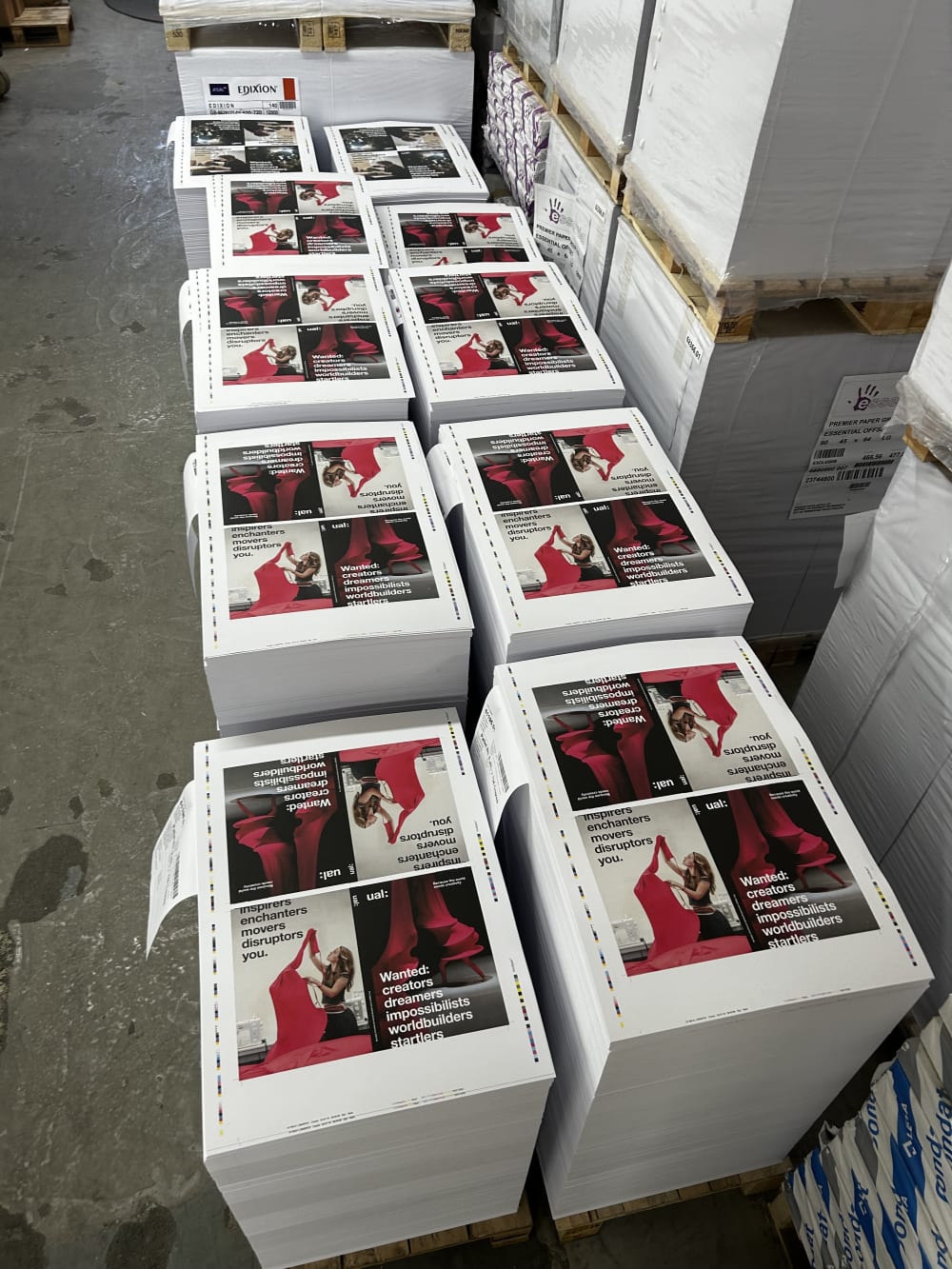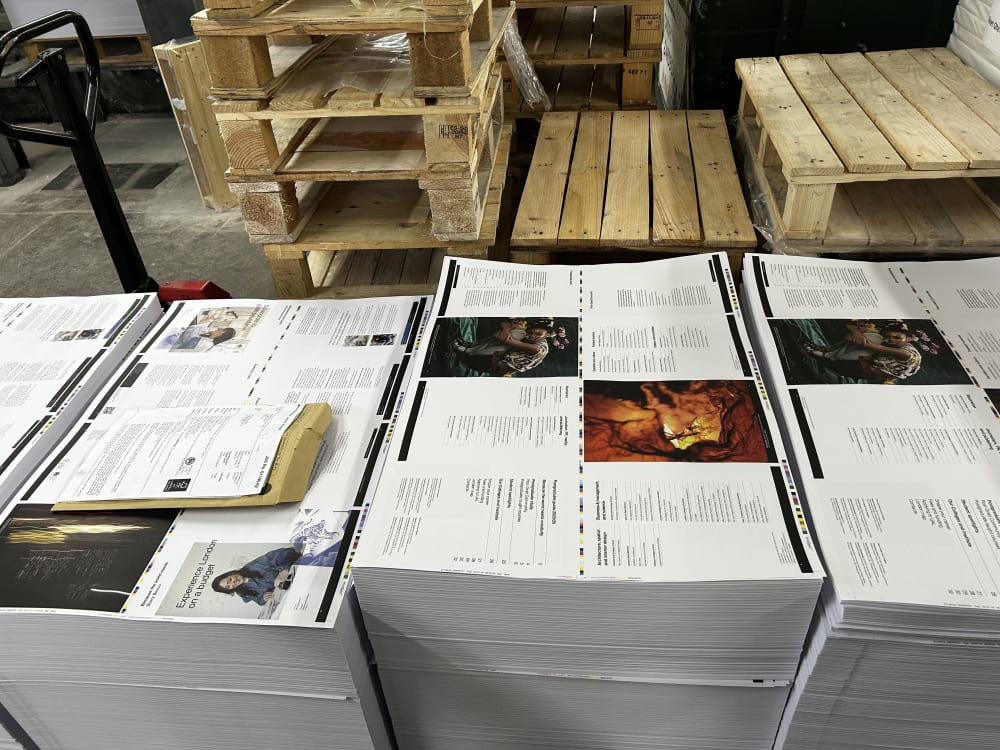
Sustainability: How we use green printing to create the UAL prospectus

- Written byRachel McClure
- Published date 14 February 2023

At UAL, sustainability is central to everything we do. From our corporate operations and initiatives to the classes we teach and materials we use. We’re mindful of the impact we have upon the world around us. And that goes for our prospectus too.
So, why have we created a printed prospectus this year? We carried out a wide range of research with potential students including focus groups and surveys to find out if a printed prospectus was still necessary. They overwhelmingly told us YES – they still want and expect to see a printed prospectus when making a decision about university. They told us they find the prospectus a highly visual, tactile, shareable, and even collectable, tool. But they’re concerned about its environmental impact, so making it sustainable is really important.
When deciding who to work with to create our prospectus, we looked for printers who go above and beyond to find more sustainable way to print. This is why we chose to work with Impress Print Services, a Carbon Balanced Printer. Their green agenda ensures the production of our prospectus involves only the most environmentally friendly methods and materials.
Chatting with Jon Spearink, Business Development Director at Impress Print Services, we learnt more about Carbon Balanced Printing and how it can help us with the sustainable production of our prospectus.

Impress Print Services has been a Carbon Balanced Printer for over 8 years but what exactly does this mean?
Carbon Balanced Print is the highest statement of integrity for users and producers of printed products. A Carbon Balanced Printer has measured the impacts of the paper as well as the production and balanced (offset) with international conservation charity, World Land Trust (WLT). WLT offsets these emissions by protecting threatened habitats that would otherwise have been lost, avoiding the release of stored carbon. This also enables the regeneration of degraded habitats, which gradually re-absorb atmospheric CO2.
What made you decide to transition into a Carbon Balanced Printer?
We want to play our part in protecting our planet, but we also know it’s good business logic. It makes sense to reduce waste and recycle more.
The Carbon Balanced programme with World Land Trust offers what we believe is the most credible, responsible, sustainable and effective choice for the global climate, for threatened habitats and wildlife, for local communities, and for our business.
Have you been confronted with any challenges along the way?
The European paper industry is a world leader when it comes to sustainably sourced raw materials, renewable energy and recycling rates. Yet the myths around paper are still prevalent amongst consumers. From “European forests are shrinking” to “only recycled paper should be used”. Often the source of these misconceptions stem from misleading information about paper and its impact on the environment.
Paper has been the preferred communications medium for 2,000 years. Even in today’s digital world, it continues to be highly effective, and when produced, used and disposed of effectively, is inherently sustainable.
Impress Print Services support TwoSides.info to foster a better understanding of our industry’s environmental credentials, print and paper. Due to its myriad of uses, from commercial applications to the basis of learning and creativity, paper will remain an essential medium for many generations to come.

Achieving sustainability across all our activities is a core initiative at UAL. Can you explain what steps you took to ensure our prospectus is produced using the most sustainable and environmentally friendly methods and materials?
We power our equipment using electricity generated from our 380 on-site solar panels. The first installation of solar panels on our main building generates approximately 25% of the power used to produce all lithographic printing, including that of the UAL prospectus. Further solar panels were installed in August 2022, generating all the power needed over a year to run our digital building and EV charging. The remaining power is sourced from renewable sources. Even though this power is from renewable sources, we include this in the calculation for our total unavoidable emissions. These are then balanced by investing in the WLT scheme.
The paper used in the prospectus is made using FSC materials, ensuring the pulp is made from sustainable sources. Over 70% of the energy used by UPM mills is from renewable and non-fossil sources. The UPM mill producing UPM Fine operate biomass CHP plants, which generate much of their heat and electrical energy needs. The fuel for biomass is the waste material from the paper making process.
Impress balance the emissions from the paper making process and the print production, enabling the prospectus to be fully Carbon Balanced using the World Land Trust.
And finally, what do you think the future holds for you and for sustainable printing more generally? Do you have any upcoming plans to further improve your sustainable efforts?
Impress Print Services recognises the threat of the climate crisis, and we aspire to reach net zero by 2030. We've achieved a 90% reduction in Scope 1 and 2 emissions since 2014 – and we're accelerating further. By driving continuous progress in de-carbonising our value chain, we continue to lead the way in advancing fully sustainable printing solutions.
